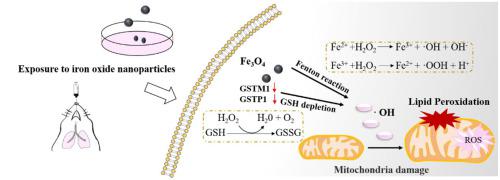NanoImpact ( IF 4.9 ) Pub Date : 2021-06-22 , DOI: 10.1016/j.impact.2021.100338 Wanjun Zhang 1 , Jinling Gao 2 , Lin Lu 1 , Tsendmaa Bold 1 , Xin Li 1 , Shuo Wang 1 , Zhishang Chang 1 , Jing Chen 1 , Xiao Kong 1 , Yuxin Zheng 1 , Mingliang Zhang 3 , Jinglong Tang 1

|
Glutathione (GSH) and glutathione-S-transferases (GSTs) are two frontlines of cellular defense against both acute and chronic toxicity of xenobiotics-induced oxidative stress. The contribution of GSH and GST enzymes to signaling pathways and the regulation of GSH homeostasis play a central role in the detoxification of numerous environmental toxins and impurities. Iron oxide nanoparticles stemmed from traffic exhaust, steel manufacturing, or welding as a potential environmental pollution can lead to adverse respiratory outcomes and aggravate the risk of chronic health conditions via persistent oxidative stress. In this work, two kinds of acute exposure experiments of iron oxide (Fe2O3 and Fe3O4) nanoparticles in cells and in vivo were conducted to evaluate the GSH levels and GST activity. Our current research presented Fe3O4 nanoparticles at lower concentrations (≤100 μg/ml) seem to be more toxic to the human bronchial epithelial cells as their consumption of GSH and decrease of GST activity. The catalysis activity of Fe3O4 nanoparticles per se may contribute to the intracellular GSH consumption along with inhibition of glutathione-S-transferase class mu 1 and P (GSTM1 and GSTP1) active site and expression decrease of GSTM1 and GSTP1. Accordingly, the GSH consumption and decrease in GST activity directed to the further lipid peroxidation regarded as an earlier marker for toxicity evaluation of iron oxide nanoparticles, and relevant intervention may be effective for prevention of respiratory exposure induced damage from iron oxide nanoparticles.
中文翻译:

细胞内 GSH/GST 抗氧化剂系统变化作为氧化铁纳米颗粒毒性评估的早期生物标志物
谷胱甘肽 (GSH) 和谷胱甘肽-S-转移酶 (GST) 是细胞防御外源性物质诱导的氧化应激的急性和慢性毒性的两条前线。GSH 和 GST 酶对信号通路的贡献和 GSH 稳态的调节在众多环境毒素和杂质的解毒中发挥着核心作用。来自交通尾气、钢铁制造或焊接的氧化铁纳米颗粒是一种潜在的环境污染,可导致不良的呼吸系统后果,并通过持续的氧化应激加重慢性健康状况的风险。在这项工作中,两种氧化铁的急性暴露实验(Fe 2 O 3和 Fe 3 O 4) 对细胞和体内的纳米颗粒进行了评估,以评估 GSH 水平和 GST 活性。我们目前的研究表明,较低浓度(≤100 μg/ml)的 Fe 3 O 4纳米颗粒似乎对人支气管上皮细胞的毒性更大,因为它们消耗 GSH 和降低 GST 活性。Fe 3 O 4的催化活性纳米粒子本身可能有助于细胞内 GSH 的消耗,同时抑制谷胱甘肽-S-转移酶 mu 1 类和 P(GSTM1 和 GSTP1)活性位点以及 GSTM1 和 GSTP1 的表达降低。因此,GSH 消耗和 GST 活性降低导致进一步脂质过氧化被认为是氧化铁纳米颗粒毒性评估的早期标志物,相关干预可能有效预防氧化铁纳米颗粒引起的呼吸道暴露损伤。


























 京公网安备 11010802027423号
京公网安备 11010802027423号